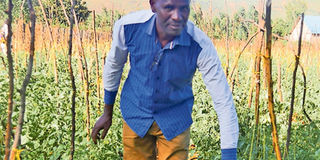Tomatoes bring in the cash for university don

Dr Robert Mburung’a in his tomato farm in Mwera village, Tigania East, Meru County. He grows his crops under drip irrigation, getting water from Amka project, a national government initiative that enables locals to pump water from a single source into their tanks for use. PHOTO | PAULINE ONGAJI | NMG
What you need to know:
- Besides tomatoes, Dr Mburung’a, who holds a PhD in education psychology from Kenyatta University, has cultivated various crops, including melons, butternuts and onions. But of all these, tomatoes are his favourite because of their good returns.
- He grows his crops under drip irrigation, getting water from Amka project, a national government initiative that enables locals to pump water from a single source into their tanks for use.
- The don starts by planting his own tomato seedlings in trays before transporting them to the farm. “It is the only way to guarantee quality seedlings but it comes at a huge price since you have to budget for the seeds, trays and labour,” he explains.
- His main challenge is diseases like powdery mildew and anthracnose, problems that Kathia Mwenda, an agronomist based in Meru, says one can overcome by using proper farming methods, as well as use of copper-based fungicides, which can be applied through the drip irrigation system.
Dressed in brown trousers, a blue shirt and white shoes, Dr Robert Mburung’a walks in his tomato farm in Mwera village, Tigania East, Meru County, scouting for pests underneath the plant’s leaves.
It is on a Saturday, and as has become his routine, Dr Mburung’a has driven from Kibwezi in Makueni County — where he teaches religious education and history at Kivuthini Secondary School — to the farm in Tigania, some 300km away to check on his crops.
“I juggle my work as a head teacher, a lecturer in three universities, and farming, which I have been doing for the past five years,” says the farmer, who works part-time at African Nazarene, Kenya Methodist and Umma universities, where he teaches psychology.
Besides tomatoes, Dr Mburung’a, who holds a PhD in education psychology from Kenyatta University, has cultivated various crops, including melons, butternuts and onions. But of all these, tomatoes are his favourite because of their good returns.
“I planted the crop first in 2016 and harvested more than 42 tonnes, making a good profit,” says the teacher who farms on one acre under irrigation.
In January, he planted over 14,000 tomato plants in 60 rows, each having more than 240 stems.
He grows his crops under drip irrigation, getting water from Amka project, a national government initiative that enables locals to pump water from a single source into their tanks for use.
“Starting was quite capital-intensive. I invested more than Sh150,000 to put up the whole system, which includes tanks and pipes. Part of the money went to cultivating the land and buying the seeds,” he says.
DISEASES' CHALLENGES
The don starts by planting his own tomato seedlings in trays before transporting them to the farm. “It is the only way to guarantee quality seedlings but it comes at a huge price since you have to budget for the seeds, trays and labour,” he explains.
But this model has ensured that most of his plants survive once transplanted and he gets more yields.
Last weekend, Dr Mburung’a harvested 220kg of tomatoes and he expects to pick even more in the coming days.
“I have some 14,000 plants, and I harvest at least 5kg of tomatoes from each, thus if all goes well, I will get at least 50 tonnes but of course one loses some of the produce,” says the farmer, who sells the fruits to brokers in Meru and Isiolo at Sh55 per kilo.
His main challenge is diseases like powdery mildew and anthracnose, problems that Kathia Mwenda, an agronomist based in Meru, says one can overcome by using proper farming methods, as well as use of copper-based fungicides, which can be applied through the drip irrigation system.
“Last season, I planted butternuts and harvested eight tonnes, which made me realise the potential of the crop,” he says. He is planning to grow watermelons in July, once he is done with tomatoes.
He also has to deal with the possibility of natural disasters such as floods and hailstones that three years ago ruined more than a quarter of his crop.
“Out of the 14,000 plants, I lost more than 4,000 to hailstones,” explains the 51-year-old don, who employs one worker and hires three others on need basis.
He has applied for voluntary retirement from Teachers Service Commission as per the law, and hopes to leave the profession this month to go to full-time lecturing and farming.





